Brian Meert's Blog, page 62
November 22, 2020
10 Instagram Stories Examples to Inspire Your Marketing Campaigns

NOV. 19, 2020

Alex Bracken / Unsplash
Just how effective is Instagram as a marketing medium? With more than 1 billion users as of January 2020, Instagram is one of the largest social networks worldwide. Half of these users, around 500 million, use Instagram Stories every day.
Stories has now surpassed Snapchat as the most popular short-form content-sharing platform. With Facebook (which owns Instagram) throwing its full support behind the technology, the feature won’t be going away any time soon.
Businesses have now made Stories a crucial part of their marketing strategy. Around one-third of the most-viewed stories come from business accounts. Advertisers are now spending 23% more on IG-focused content compared to two years ago, and much of this growth is driven by Stories. Because Instagram allows businesses with 10,000 followers or more to post links to e-commerce sites, customers can now make purchases directly from an IG Story.
Instagram Stories are effective because they are non-intrusive, and users can choose when and if to interact with them. Unlike channels such as email, where spam filters determine what a user receives in their inbox and what doesn’t make it, Stories are more targeted and generate more purposeful clicks.
If your brand’s marketing strategy doesn’t include using Instagram Stories as a marketing channel, you might be missing out on a lot of potential revenue, especially among younger consumers. As long as you follow IG Stories best practices, you will improve your user engagement rates significantly. Here are some examples of brands that have gone all-in with their IG Stories ad campaigns.
Prada: Catering to Target Audience
Luxury fashion brand Prada (@prada) doesn’t always post Stories on their global Instagram account, but when they do, they’re bound to be mysterious and enticing. In fact, when Prada announced its 2020 Holiday collection, it set the bar high for all other fashion houses’ IG campaigns.
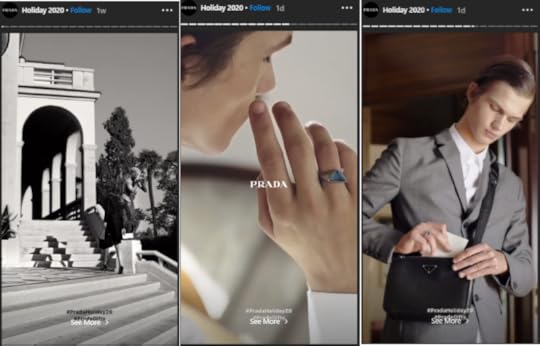
@prada / Instagram
The brand’s announcement was low-key but elegant, starting with the first few Stories images being shot in monochrome. Each succeeding story had a bit more color in it, and some panels had polls to engage the audience. There was no need for a fancy soundtrack or celebrity endorsers. The brand and the products spoke for themselves.
Prada succeeded in maintaining its air of luxury and exclusivity through its IG Stories campaign. While Instagram is an open platform, Prada’s marketing language spoke directly to its elegant, stylish, and affluent customer base.
National Geographic: Partnering with Like-Minded Brands
With travel restrictions in place over large swathes of the globe, more people are staying home and working from home than ever in 2020. Unfortunately, this can disrupt our mental and physical health. This is why National Geographic (@natgeo), which is known for excellent nature photography, recommends that people spend plenty of time outdoors, whether walking through a forest or climbing up a peak.
The magazine has a long history of partnering with brands that share its values. The print version of the publication, for example, used to carry ads for cameras and all-terrain vehicles. This tradition of collaborating with like-minded brands carries over to its IG Stories campaigns.
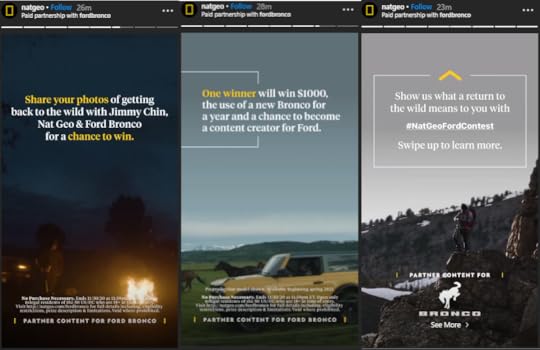
@natgeo / Instagram
This November, National Geographic partnered with Ford Bronco to encourage people to submit their nature photographs for a contest judged by famed nature photographer Jimmy Chin. This contest is not only intended to collect fine nature photographs. It’s also a way for NatGeo and Ford followers to enjoy life a bit more despite the current health crisis by going out into nature.
Nike: Championing Diversity
While most sports brands have just one IG account, Nike chooses to segment their Instagram presence according to the product line. There’s one main Instagram account for Nike, then there are separate accounts for Nike Basketball, Nike Running, Nike Sportswear (@nikesportswear), Nike Women, and even Nike Skateboarding.
With such a diverse product line catering to everyone from weekend warriors to some of the greatest athletes on the planet, one would expect Nike to be vocal about ethnic and cultural diversity. The brand does not disappoint in this regard as it chose to feature historically Black colleges and universities (HBCUs) in its #YardRunners campaign.
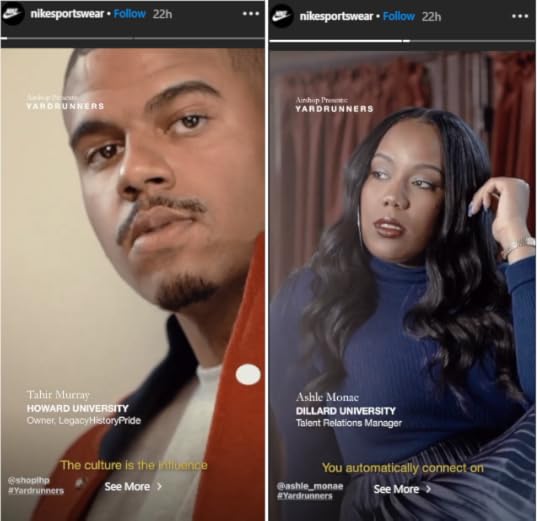
@nikesportswear / Instagram
The term “yardrunner” is closely tied in with HBCU fraternity and sorority culture, and for its October campaign, Nike featured alumni of Howard and Dillard universities who have achieved greater heights thanks to the support systems they developed in college. This was the brand’s way of paying tribute to the institutions that helped shape Black culture into what it is today.
Nintendo: Cultivating Customer Loyalty
For Nintendo (@nintendo), the customer journey doesn’t end when a customer purchases a console or a game. In fact, when done right, it’s just the beginning of a long, fruitful relationship.
Let’s say you bought the Mario Kart Live: Home Circuit game. As a beginner, building a good AR-enabled kart course might be tricky, and your first few courses might not be able to support faster cars. Nintendo’s IG Stories help Mario Kart Live users create more challenging circuits, even suggesting a course in the shape of an infinity sign.
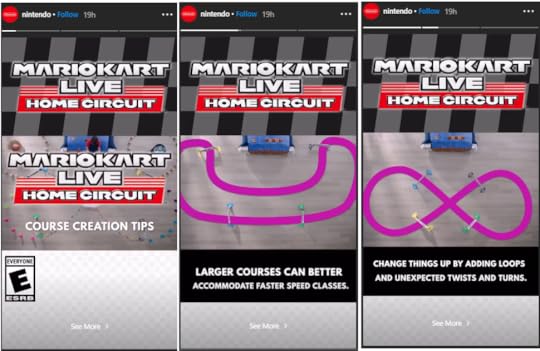
@nintendo / Instagram
With the continued success of the Mario Kart Deluxe game (26.7 million copies sold to date), it looks like Mario Kart Live: Home Circuit will continue to be loved by fans, especially with the course suggestions above.
Disney: Engaging Followers
While entertainment giant Disney (@disney) has diversified into other fields such as broadcasting, theme parks, sports, and independent films, it is still best known for its iconic cartoon characters, including Mickey and Minnie Mouse, Donald Duck, Pluto, and Goofy. Almost everyone has a favorite Disney character, and most people associate Disney with good childhood memories.
It shouldn’t surprise us that even Mickey Mouse has his own Instagram account. Did you know that the first words he ever spoke on screen were “Hot dogs”? Neither did we — we only learned about it when we took the Mickey Quiz on Disney’s IG Stories!
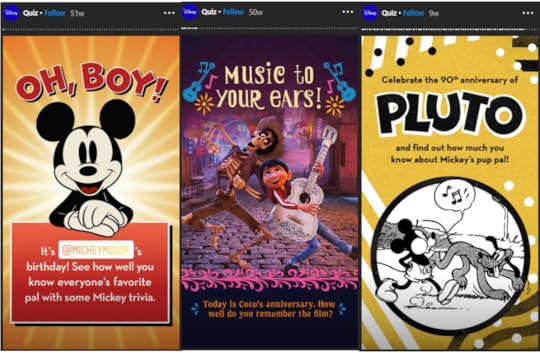
@disney / Instagram
Aside from Mickey Mouse, Disney’s Instagram account also has IG Stories quizzes about their other iconic characters and feature films, such as Pluto and Coco. Taking these quizzes is like taking a trip back to childhood and Saturday mornings spent watching Disney cartoons. It looks like Disney has found the perfect way to mix classic content and Instagram Stories to keep its fans engaged.
NBA: Generating Buzz
The National Basketball Association (@nba) features some of the greatest players on the planet today, and each year players, teams, and fans experience new highs and lows. Will the Warriors recover from their disastrous season? Was the Lakers’ “bubble” championship the beginning of a dynasty?
The new season kicks off with the annual NBA draft, where teams pick from a pool consisting of the most talented young players from the National Collegiate Athletic Association and leagues outside the US.
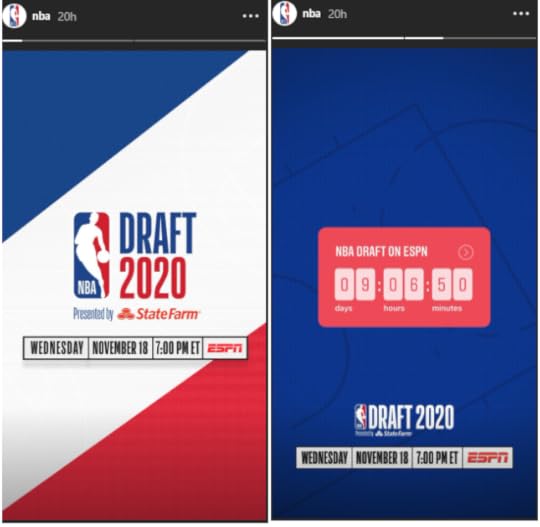
@nba / Instagram
For fans watching out for the 2020 NBA Draft, the NBA’s IG account is also counting down the days, hours, and minutes with them. The countdown builds up the anticipation and promises some stability in what has been a topsy-turvy year for sports fans everywhere.
Stephen Colbert: Stories Takeover
Stephen Colbert has successfully stepped out of his “Colbert Report” persona and settled in as the host of a late-night show. Even if the pandemic has kept A Late Show (@colbertlateshow) from packing in the crowds, Colbert is still actively producing and publishing content across different platforms.
For instance, just a few weeks back, Colbert featured country music legend, Dolly Parton, on one of his episodes. There couldn’t be a more unlikely crossover, but the duo was able to pull it off and entertain fans of both Parton and Colbert.
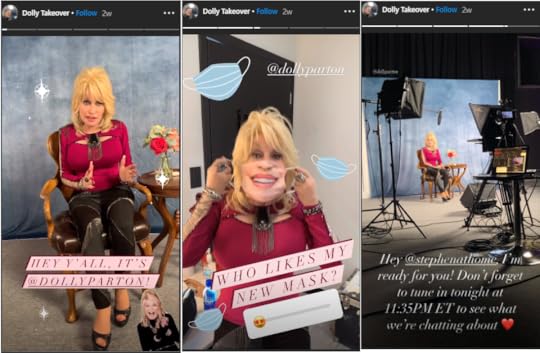
@colbertlateshow / Instagram
A Late Show promoted Parton’s guest appearance by letting her take over the show’s Instagram Stories for one day. Parton walked the show’s IG followers through her daily schedule, starting with her makeup routine and ending with an invitation to watch the show. Colbert is fond of IG Stories takeovers, and it’s been working out splendidly for both him and his guests.
Forever 21: Promoting Other Platforms
Gone are the days when brands placed all their bets on just one social media platform. People have learned that it’s important to have a consistent presence on at least the three major networks (Facebook, Instagram, Twitter), then explore other networks in addition.
Forever 21 (@forever21) is no exception to this rule. Aside from publishing content for more than 15 million followers on Instagram, it also generates content for TikTok, which is one of the fastest-growing social platforms today. Despite threats of a U.S. ban on the app, its user figures are expected to continue rising as it gains popularity among younger people.
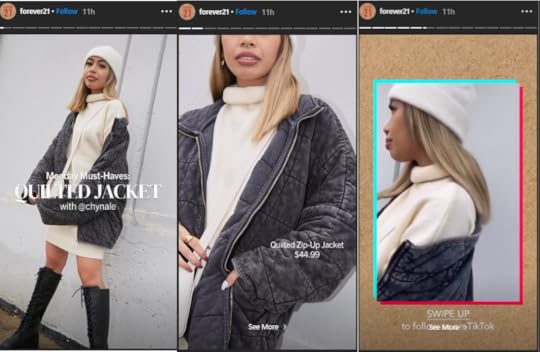
@forever21 / Instagram
Forever 21’s latest campaign, featuring southern Californian influencer Chyna Le, showcases its upcoming fall and winter collection. But instead of attaching a link to its online store, the brand invites followers to follow Chyna’s TikTok account as well. It’s a sign that Forever 21 is really serious about boosting its presence on that platform, where the brand already has close to 22,000 followers.
The New York Times: Featuring Diverse Voices
When it comes to politics and divisive issues, people need to hear different voices in order to form an educated opinion. The New York Times (@nytimes) recognizes this need for diversity, and one of their advocacies is featuring people from all walks of life across America in their Instagram Stories.
Their post-election IG Stories campaign, for example, asked voters about their hopes and dreams in the next four years. While the people they featured included Democrats and Republicans, city-dwellers, and people from the rural areas, they all agreed on one thing: they all wanted to get along together and start working for a better future.
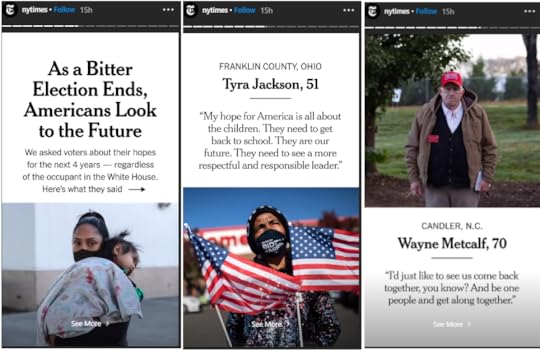
@nytimes / Instagram
When your brand is trying to expand its reach (as the New York Times has successfully done far beyond New York and the northeastern US), you need to listen to people who don’t necessarily agree with you. In fact, as you share your thoughts with them, you might find out that you have a lot more in common than you think.
Taco Bell: Featuring UGC
Brands love Instagram Stories because it is one of the most interactive platforms out there. Users can send direct messages and reactions from IG Stories. However, by featuring user-generated content, you take your engagement with your followers to a whole new level.
We saw something like this from Fast food chain, Taco Bell. The brand (@tacobell) is particularly good in featuring content created by its followers, which falls under their well-designed marketing plan. Every Monday, it posts fan art submitted using the hashtag #TacoBellMuse to its IG Stories. Aside from showing Instagram how much everyone just loves Taco Bell, the brand gives these up-and-coming artists exposure to more than 1.5 million people who follow the Instagram channel.
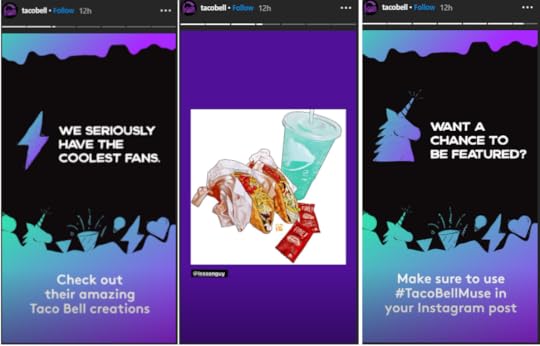
@tacobell / Instagram
Taco Bell might claim that it seriously has the coolest fans, but we think the way the company promotes fan-created content is just as cool.
How to Create an Instagram Stories Campaign That Works
You might be feeling inspired after seeing all the IG Stories campaigns above. If you’re still not using Stories and would like to start somewhere, you need to know the things that go into a successful IG Stories campaign:
Create content that is made for Stories. The dimensions should be correct, and video clips should be 15 seconds long at most. This means you should also keep text to a minimum. Less is more!
Use either a video or several slides to tell a longer story. Single static images don’t work as well as they normally would because your audience can only view them for a few seconds.
Make your campaign interactive. Whether you’re asking your followers to respond to a poll, swipe up to go to your landing page or an affiliate page, or submit fan-created content, always go for active engagement.
Keep it real. Use the voice your brand normally uses. If your brand is serious and luxurious like Prada, go ahead and follow your branding. But in many cases, nothing beats a healthy dose of humor.
Your Stories must provide something of value. If your audience sees that your Stories just repeats something you’ve posted previously, your brand won’t get the traction it needs. However, if your IG Stories campaign offers something you haven’t offered yet, like a special discount, a giveaway, or a chance to get involved directly, your audience will get involved.
Instagram Stories is one of the best channels you could ever use to reach out to younger audiences. If you want to get a glimpse of what will work with a younger market, try looking at the accounts that your target audience follows. Keep pushing your creative boundaries and don’t be afraid to try new things. Best of luck with your campaigns!
By Owen Jones
November 17, 2020
Twitter Rolls Out a Stories Feature, “Fleets”

NOV. 17, 2020
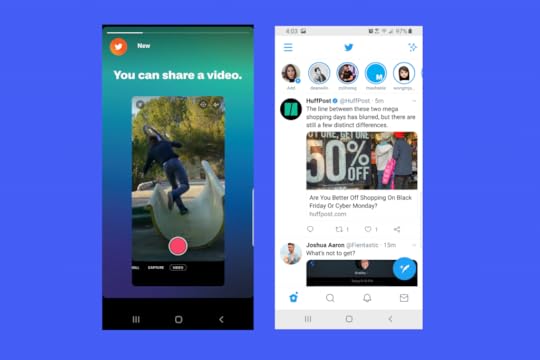
Twitter is joining the bandwagon by rolling out its own version of a Stories-esque feature called “Fleets.”
Much like Instagram Stories, Fleets, which appear on top of the Twitter Feed, are 15-second ephemeral photos or videos that last for only 24 hours.
To create a Fleet, users can click on their profile image from the left side of the Fleets bar.
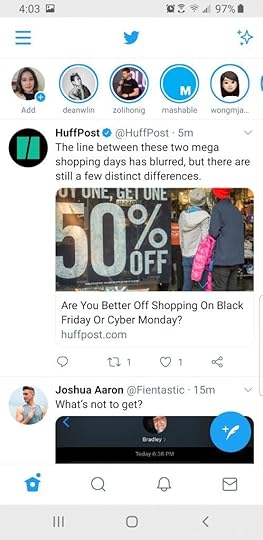
Unlike Instagram Stories, however, Fleets have limited capability. There are no Polls, face filters, or Boomerangs to be seen here. For now, users can only post text, a video, or an image.
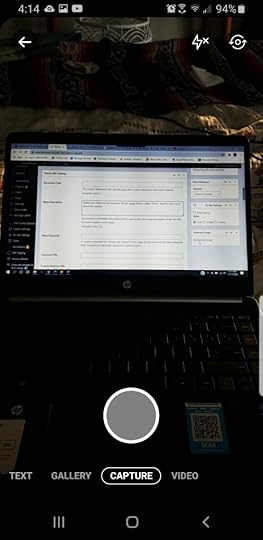
Twitter is the latest social media platform to adopt the Stories feature. LinkedIn, too, debuted its own version last month but with a surprising twist: Users can see the people who viewed their Stories, a feature that even Instagram doesn’t yet have.
Before LinkedIn, Pinterest also was trying its hand with the Stories feature.
Although ephemeral clips of images and photos originated from Snapchat (“Snaps”), Instagram Stories is currently taking the lead in terms of popularity and usage, and it seems like competitors want a slice of that pie, too.
By Anne Felicitas
November 16, 2020
6 Important Marketing Theories and How to Apply Them on Social Media Campaigns

NOV. 16, 2020

Campaign Creators / Unsplash
Whether you’re a veteran marketing professional or you’re transitioning to the industry for the first time, your campaigns need to have a solid foundation in marketing theories. Based on customers’ desires and motivations for taking action, these concepts help us understand basic fundamental truths about the impact of marketing.
The most effective marketing theories are based on real-life observations and are useful not just for marketing but also for many different aspects of business. Agencies, such as a custom design web agency or an advertising agency, usually uses a multi-pronged approach for campaigns, influenced by different marketing theories and personal experiences with marketing.
Today, we will discuss six theories that can help you understand your customers and create campaigns that address their needs.
Maslow’s Hierarchy of Needs
Some of you might remember this one from your college psychology class. The five-stage Maslow’s Hierarchy of Needs classifies needs according to five categories: biological, safety, love or belonging, esteem, and self-actualization. This theory states that humans need to satisfy the most basic needs of survival before moving on to higher-level needs.
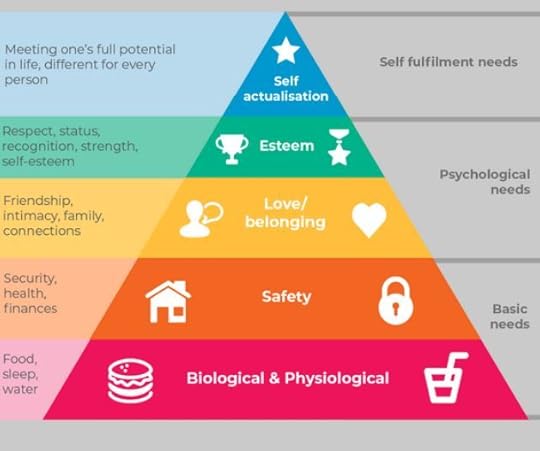
Source: professionalacademcy.com
In social media marketing, this means you need to understand the level of hierarchy your customer is likely to be in when they’re interacting with your brand. There’s no point marketing through the lense of self-actualization to people who are trying to achieve a sense of security. In other words, which of the five needs are your customers looking to fill when they interact with you? It’s likely to be one of the top three in most cases.
The needs people are looking to meet with social media usage can be different depending on the platform, and you should tailor your content accordingly. For example, many people use platforms like Facebook and Instagram to connect with friends and family, fulfilling the “belonging” need. LinkedIn, on the other hand, tends to be used by people trying to find jobs, build their professional networks, or check out new solutions for work-related concerns. This could fit anything from “safety” (needing a job to pay the rent) to “self-actualization” (achieving a dream).
Decide which one applies to your target audience on each particular platform and plan your content to reflect that.
Seven P’s of the Marketing Mix
The concept of the marketing mix has been around since 1960, when the original four P’s — product, place, price, and promotion — were first used to analyze and create marketing campaigns.
This marketing theory has since been expanded to seven P’s, with the addition of people, processes, and physical evidence. This expanded version allows marketers to use the theory to create campaigns for services. Some digital marketing specialists even add an eighth P, productivity and quality, to reflect how businesses pass on productivity and value to their customers.
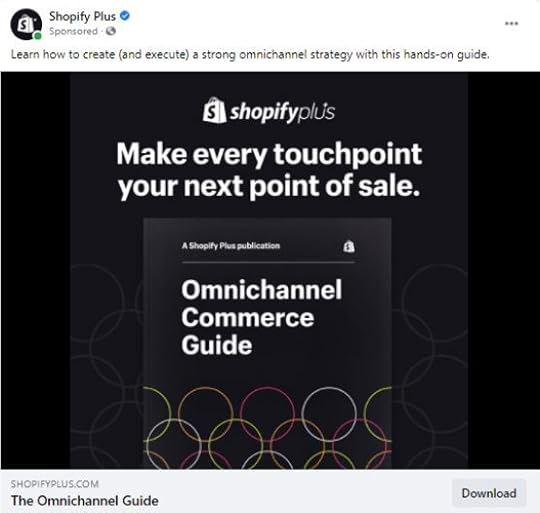
Shopify / Facebook
Shopify, pictured above, offers more than just a way for merchants to sell products online (product). It also produces guides and resources for its customers to help them improve their e-commerce stories (physical evidence).
This social media campaign works because it does not only promote the brand and product, but it also adds value to the product (promotion, price) by giving its readers ideas to increase sales and make more money from their Shopify stores. This campaign ticks off at least four of the seven P’s in the Marketing Mix theory. Always aim to hit at least three of the seven P’s in each of your social media campaigns — the more the better!
SWOT Analysis
If you’ve ever worked in a role that required strategic planning, you are probably familiar with the SWOT (strengths, weaknesses, opportunities, threats) analysis. This theory can be widely applied to almost any marketing campaign, and we recommend you use it periodically to assess how things are going and where your efforts could be fine-tuned.
At its simplest form, you identify the strengths and weaknesses of your product, service, or campaign, and then identify the opportunities and threats it faces. The first two factors are internal while the last two are external.
Aim to identify the following:
Strengths: what your product or company does well
Weaknesses: what your product or company doesn’t do very well
Opportunities: what new technologies or markets are in the pipeline for your brand
Threats: what your competitors have that you don’t
Remember that opportunities, threats and strengths, weaknesses are not mutually exclusive. Something can easily fall into more than one category.
Let’s look at this example:
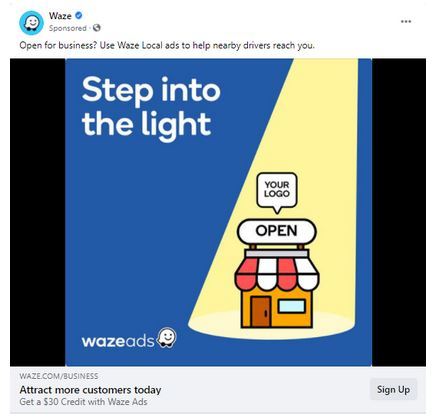
Waze / Shopify
This Facebook ad for Waze presents an opportunity for local businesses to list themselves on the platform, bringing more new users to Waze. Many businesses have closed due to COVID-19, and those that have stayed open have had trouble attracting customers. This could be identified as both an opportunity (more businesses will be doing delivery, putting them in the market for Waze’s services), and a threat (many companies are tightening their budgets and losing money).
Whenever you start and finish a big social media campaign, run a SWOT analysis to project how you think it will go and then analyze how it actually went.
Consumer Decision Making Process
Marketers use the Consumer Decision Making Process to understand how a buyer makes decisions, from the moment they are first exposed to a brand or product to the point of purchase. It can be divided broadly into five sections:
Awareness: The customer becomes aware of a problem they need to solve or a need they want to satisfy.
Interest: The customer starts looking around and researching potential products or solutions.
Consideration: The customer has trimmed down their choices and is debating the pros and cons of each choice. They eventually make a choice based on factors like quality, price, or previous experience with the brand.
Purchase: Armed with enough knowledge, the customer is now able to justify making a purchase. They go to the sales platform for the product, add it to their cart, and click on “Buy Now.”
Loyalty: Many customer journeys end with the purchase stage. However, providing an excellent post-purchase experience is crucial to ensuring that the customer will make another purchase in the future or will recommend your product to others. This is where loyalty begins.
If this seems familiar, that’s because these stages are similar to a typical customer marketing funnel.
The content you put on social media serves different purposes at different funnel stages. For example, the way you’ll engage with your audience when you’re trying to attract brand new customers is different to how you’ll interact when you’re aiming to build loyalty with existing fans. Customers just becoming aware of your product need a different approach to those who are almost ready to buy. Therefore, you must be crystal clear on which step in the decision making process you’re targeting with each social media post.
Here’s an example:
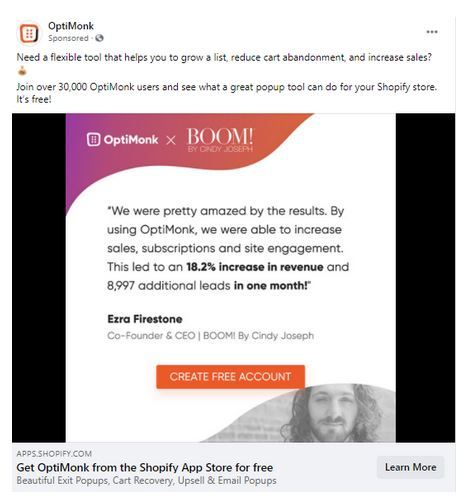
Facebook / Optimonk
This Facebook ad for Optimonk acknowledges that Shopify sellers need help with driving traffic to their stores (i.e. the customer is aware of the problem they need to solve). It then suggests the Optimonk pop-up tool as a solution and invites ad viewers to learn more about the tool. This ad is an example of great top-of-funnel content, as it raises awareness then gives the user an inside peek into the tool’s capabilities.
Porter’s Five Forces
The Porter’s Five Forces model is one of the marketing theories that are most widely taught in professional marketing courses. Just like the SWOT analysis method, it looks at various forces that can affect a brand and its marketing. However, it differs from SWOT in that it focuses solely on external factors. Let’s look at each of the five forces:
Competition: This includes the number of competitors in the space you’re trying to gain a foothold in, the resources they have, their customers’ loyalty, and your own competitive strategy.
New Entrants: This is particularly important when you’re trying to introduce a new product or maintain your leadership spot. You will need to consider barriers to entry, government policies (such as franchising laws), and industry monopolies.
Substitution: While “substitution” normally means replacing a product with something similar, it actually refers to an entirely different product in this context. For example, instead of buying a traditional gas-guzzling car, you choose to buy a Tesla. This means you will have to consider the cost of switching (such as installing a charging station at home) and whether there are any real differences between two or more products (in this case, performance and emission levels).
Suppliers: Your product won’t exist without suppliers. With the pandemic disrupting logistics and supply chains all over the world, the essential role of suppliers has become even more apparent. Don’t forget that you can shop around between suppliers and negotiate the best prices.
Buyers: Your buyers are the single most influential of the five forces. They will determine whether your product is too expensive or if it’s worth what it costs. You will need to study your buyers’ preferences, their ability to pay, and the things they consider before they make a purchase.
You can apply Porter’s Five Forces even if your product isn’t quite like anything else currently on the market. That’s because someone will eventually find a way to make a cheaper product that serves the same or a similar purpose. But how does this apply to social media?
Since Porter’s Five Forces is all about external pressures, you need to find a way to position your product as a uniquely beneficial solution for your audience. Here’s an example:

Facebook / eToro
A trading platform called eToror has a business model that revolves around removing barriers to entry when it comes to investing. This company’s ad emphasizes the ease of getting started and the ability to learn the art of trading by copying what top investors do. In other words, would-be investors can get started right away instead of spending a lot of time studying the stock market. This is good news for the user and good news for eToro.
When you think of Porter’s Five Forces, you should be considering your unique selling proposition (USP). What makes your company or product different from anything else on the market? Identify your competitive advantage and make the most of it.
Market Segmentation
Though you might want to claim that your product is “for everyone,” if you find yourself saying this then you might want to revisit your marketing strategy. Nothing is for everybody! This implies that your product lacks something to make it appealing to a specific audience and therefore is likely to be very generic. While focusing on a smaller market section might seem counterintuitive, market segmentation will help your business get the most out of its marketing dollar.
This process has three steps: segmentation, targeting, and positioning. The first one is pretty straightforward: It involves finding out who your customers are and dividing your potential customer base into different segments based on demographics, location, topics of interest, or behaviors. Targeting involves choosing the market segment that is most likely to respond to your marketing, while positioning involves looking for gaps in the market that your brand could fill. Many CRM systems allow you to segment your audience for email marketing purposes. But did you know you can use segmentation on social media, too?
Performing market segmentation will help you identify the best content for your audience and the platform you’ll be sharing that content on. HostGator, for example, maintains a presence on both Facebook and LinkedIn, but the content the company posts on either platform couldn’t be any more different. Here is its Facebook ad:

Facebook / HostGator
HostGator clearly did its homework with market segmentation and discovered that its audience on Facebook was a younger and less serious crowd. Using a meme-style cartoon strip and informal language worked perfectly for that demographic. Meanwhile, the company took a far more serious, technical approach to appeal to LinkedIn users, who tend to be business people and senior-company decision makers:
In other words, use market segmentation to determine who and where your target audience is, then choose the tone and theme of your social media posts accordingly.
Wrapping up
The marketing theories discussed above will help provide insight into your target audience, your competition, and the threats and opportunities facing your company. All of these can help you create social media marketing campaigns that result in more clicks, leads, and conversions. As you grow into your role as a social media marketer, using marketing theories to underpin your campaigns will become second nature.
By Ian Loew
November 13, 2020
Using Facebook Ads to Increase Black Friday Sales with Christian Sierra

NOV. 17, 2020
In this episode of Duke of Digital, podcast host and AdvertiseMint CEO Brian Meert is joined by Christian Sierra, digital marketing manager at AdvertiseMint, to discuss Black Friday strategies, including targeting the right audience, crafting an effective offer, and anticipating high advertising costs.
Who to Target
With several years of marketing experience and a Facebook Blueprint certification under his belt, Sierra has a few helpful tips in store for advertisers. He begins the conversation with insight into the ideal target audience for Black Friday ads. According to Sierra, advertisers must place 90 percent of their attention on customers in the middle and bottom of the sales funnel. These are customers who have interacted with a business in the past, whether that’s initiating a check out, visiting a website, or interacting with the business’ social media pages.
When serving ads to high-interest customers, Sierra says advertisers should prepare those audiences for the upcoming Black Friday sale. To do so, he recommends encouraging audiences to register for newsletters so that they may be notified when the first deals drop.
How to Craft Black Friday Deals
According to Sierra, to run successful Black Friday campaigns, advertisers must create explicit, competitive, and attractive offers.
“We’re all looking for the biggest deals. If it’s not over the numbers of 20 percent, people aren’t even looking. They’ll look for the next one. Give them a compelling offer.”
Advertisers should offer the most significant deal of the year, since consumers are expecting irresistible offers during this time.
In addition to offering the best deals, instilling a sense of scarcity is also an effective tactic — a product is more attractive to customers when they believe it to be in limited supply.
Of course, offering the biggest sale of the year could result in revenue loss. However, with those losses come new customers for the new year and an increase in customer lifetime value.
Black Friday Advertising Costs
Because Black Friday is a popular day to sell, a day when many businesses are serving ads to Facebook’s platform, advertisers should expect costs to rise at this time. For this reason, it’s important to target warm audiences. Cold audiences are not likely to purchase from a business they’re unfamiliar with. If targeting cold audiences is a necessity, separating cold audiences form warm audiences and allocating more of the budget to the latter group is an effective tactic.
Sierra reveals more of his Black Friday tips, including creating the most effective campaign structure, setting the right bid caps, allocating the correct budget amount, and fixing under-performing ads. To learn more about these tips, listen to the eighth episode of Duke of Digital.
By Anne Felicitas, editor
November 12, 2020
Facebook Is Banning Political Ads for Another Month

NOV. 12, 2020
 Element5 Digital / Unsplash
Element5 Digital / UnsplashFacebook announced that the ban on political and social issues ads will continue for another month. The social media company originally intended the ban to end on election day, November 4.
Political and social issues ads have a “paid for by” label and fulfill the following criteria:
They’re made by, on behalf of, or about a candidate running for public office, such as a political figure, a political party, or advocates for the outcome of an election to public office.
They’re about any election, referendum, or ballot initiative, including “go out and vote” or election campaigns.
They’re about social issues in the location where the ad is placed.
They’re regulated as political advertising.
Since election results were in a delay due to COVID, more vote-in mail, and President Trump’s refusal to concede, Facebook is continuing the ban in an effort to protect the U.S. election.
Still, Facebook did say that a lift on the ban may come sooner. Advertisers can visit this page to check on updates.
In addition to putting a hold on political ads, Facebook will also continue to direct users to its Voting Information Center, found on both the Facebook and Instagram platforms.
Since the 2016 election interference in which fake Russian ads disseminated false news and politically divisive content, Facebook has been taking bigger steps to protect elections around the globe. This ban is one of the many efforts the social media company has made, including helping users register to vote and preventing misinformation
By Anne Felicitas
November 10, 2020
How to Do Social Media Marketing on a Small Budget

NOV. 10, 2020

Chase Chappell / Unplash
The world of social media has opened up a range of marketing opportunities. With social media marketing, by focusing on the detail of your customer demographic, behaviors, and the social media platform itself, you can host a successful online marketing campaign with a minimal budget.
Companies spend an average 12% of their marketing budget on social media, which, while not an eye-popping figure, is a substantial one. It depends how big a marketing budget a company has because 12% of half a million dollar is a fairly substantial figure.
For start-ups and small businesses, their marketing budget can be tight, and matching this spend is a lofty ambition. But spending on the right social media marketing campaigns can bring a return in investment that repays the investment several times.
With your tiny budget, you’ll want to see almost-guaranteed returns. Is this possible? It is, and here, you’ll find out how.
Define and Refine Your Social Media Audience
Who you talk to on social media determines the response you get. All too often, the very open and diverse nature of social media means that some business owners associate marketing across this medium as a potential to make lots of money, and fast. If your video goes viral or your Tweet gets a million likes, it’s entirely possible, but like all marketing campaigns, activities shouldn’t be based on maybe going viral but on reaching the people you know buy your products or service. In other words, defining your target audience is vital before you spend a penny on any social media marketing campaign.
 Guilherme Stecanella / Unsplash
Guilherme Stecanella / UnsplashFor example, there are 1.82 billion daily active users on Facebook, but they are not all your customers. Taking a scattered approach to marketing on this channel, you will focus money and energy on people who will never convert to paying customers. By identifying who your customers are and which social media channels they use, a campaign will have more focus and will yield better results.
Find Out the Platforms Your Customers Are Using
Marketing on social media is not just about sales, although it will be a big driver behind a campaign. The clue is in the name – social media. If you unleash a campaign that gets people talking about your brand, conversion rates will increase. Stepping away from sales, sales, sales is a great move.
Understanding your customers will mean you’ll understand which social media channels they’ll frequent. Every platform has its own culture, and that is what draws people to sign up and engage on the platform.
Instagram, for example, as a photo-rich platform presents a glossy front that many people find appealing. It allows people to peer into other people’s lives. Compared to other platforms, Instagram tends to be seen as a positive place, although there are always exceptions.
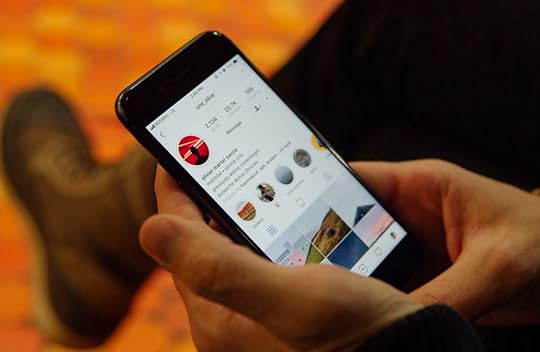
Charles Deluvio / Unsplash
Social media users can no longer be determined by age alone but by their behaviors and what they are looking for from a social media platform. For example, many Instagrammers have a high level of disposable income, which may fit with your customer demographic.
It’s essential to check who uses the social media platform you are planning to market and advertise on. With a tiny budget, you want to get the best out of each post and caption.
Pick One Platform and Do It Well
There are several social media platforms, from Twitter to Facebook, Instagram to the latest popular platform, TikTok. The temptation is to have a brand presence on all of them, but there are many reasons why this can work against you. In a nutshell, however, it’s about spreading your marketing efforts too thin.
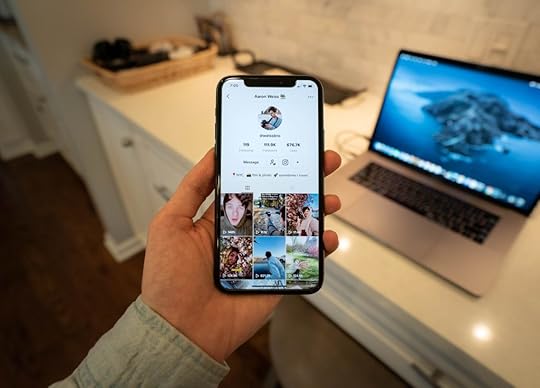
Aaron Weiss / Unsplash
To be successful on social media, you need to maintain a presence that followers enjoy engaging with. To make headway with Twitter, for example, you need to Tweet at least 15 times a day, along with paid-for ads. On Facebook, a daily post should suffice, and 11 Pins a day is the suggested norm for Pinterest…the list goes on.
Spreading your brand marketing efforts on social media compromises quality and consistency. A flurry of posts that lasts a few days won’t return the results you want. Rather than juggling all these platforms at once, choose one and post consistently and frequently. Again, this means understanding your customer demographic and the platform they are most likely to frequent.
Develop Content and Track Its Success
What works for some brands on some platforms will not deliver the same results for you. Users, followers, and customers have different expectations of brands
Using the same format of content time and again can become a little stale, as too can posting at the same times. You need to know what works and why.
Use a scheduling tool: There are various free and paid-for versions of scheduling tools that allow you to queue posts ready for publishing at days and times you decide. These tools will often have analytics attached to them, and so you can build a pattern of what type of posts work better when.
Mix up the content: From videos to captions, vary not just the format but content, too. Most social media experts agree that using subject matter that links with a brand makes more sense than throwing out seemingly random posts on an unrelated matter. Whether this includes politics or comments on social issues comes down to your brand and what it stands for.
How Much Do You Need for an Effective Social Media Campaign?
Technically, you don’t need a budget if you create and post content to social media yourself. You could outsource this work to a skilled, experienced social media expert, however.
Alternatively, you could sink your marketing budget into social media ads, another great way of reaching new audiences. And again, for a small investment, you could enjoy a lucrative return.
By Joe Dawson
November 5, 2020
How to Become an Instagram Influencer

NOV. 6, 2020

There’s a lot of talk about influencers nowadays, and Instagram is perhaps the most popular social media platform for influencer marketing. If you’re good at social media, perhaps you’ve even considered becoming an Instagram influencer yourself, but you might be stuck as to how to get started. For that reason, here’s a guide to becoming an Instagram influencer.
Why Become an Instagram Influencer?
The most obvious reason you might want to become an Instagram influencer is for the money. After all, who hasn’t seen an influencer showing off their flashy lifestyle on Instagram and thought “I want that!” at one time or another?
Although it’s possible to make money as an influencer, you need to be realistic. You probably won’t be able to quit your day job overnight or retire at 30. Still, there are reasons you might want to be an influencer:
To advertise something, whether it’s your blog, podcast, YouTube channel, services, or e-commerce store
To make a positive difference in the world and in the causes you care about
To enhance your reputation as an authority in your industry
To make social media your full-time job rather than just a hobby
Although there are no right or wrong answers to why you should be an influencer, it’s important to know what the answer is for you. There might be more than one motivating factor, of course, but you can only achieve your goals if you get really clear on what they are and why you have them.
Macro vs. Micro vs. Nano Influencers
When people hear the word “influencer,” they tend to think of those with millions of followers and a seemingly endless flow of cash. Although this is one type of influencer, it’s far from the whole picture. Did you know that even those with a relatively smaller audience can be considered influencers? Let’s take a look at the four kinds of Instagram influencers: mega, macro, micro, and nano.
At its core, the difference between the three comes down to follower count. As a rule of thumb, a macro influencer has more than 100,000 followers. A micro influencer has 10,000 to 100,000 followers, and a nano influencer has 10,000 followers or fewer. There’s also a fourth kind: the mega influencer. A mega influencer has more than one million followers. However, since it’s rare for anyone but an already well-known celebrity to reach this level, we won’t focus on it today.
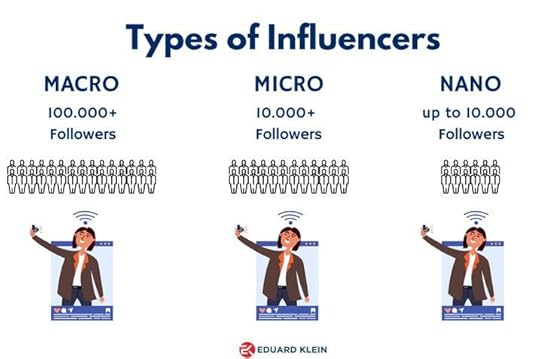
Source: eduardklein.com
Let’s look at some examples.
Photographer Jesse Driftwood would be defined as a macro influencer with his (at time of writing) 162,000 followers.
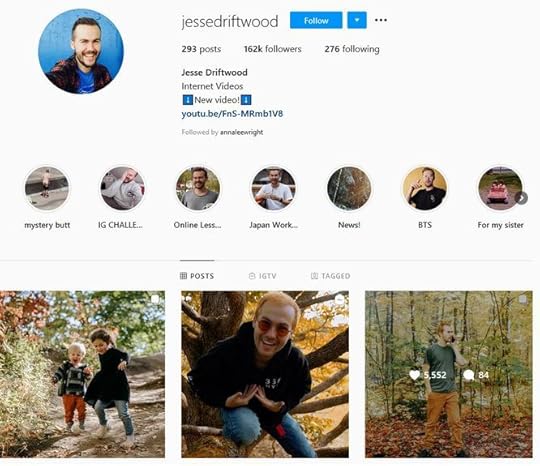
@jessedriftwood / Instagram
Driftwood shares behind-the-scenes photography from his family life, as well as travel snaps, fun selfies, and occasional insights into the photography process. His platform serves to advertise his YouTube channel, which boasts an even more impressive 190,000 followers.
Jessica Pattison DeMelfi (@jessicademelfi) is a micro fashion influencer with around 11,400 followers. She receives hundreds of engagements on each post. DeMelfi is a blogger who uses her substantial platform not only to promote her blog and to advertise products for brands but also to stand up for causes she believes in, such as Black Lives Matter and the importance of voting.
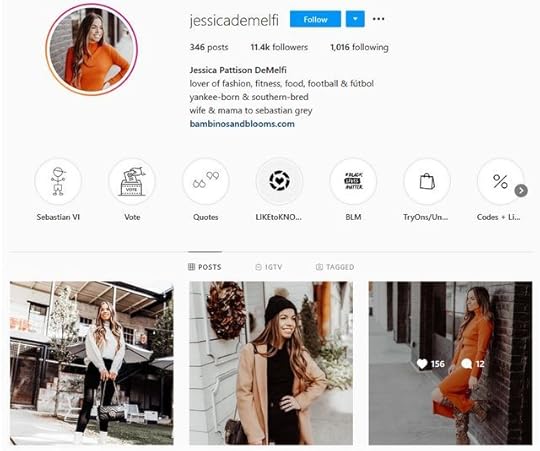
@jessicademelfi / Instagram
Sibel Oxha (@sibelsbeautybar__) is a nano influencer in the beauty niche. Though she has a relatively small following of just more than 3,500 people at the time of writing, her followers are highly engaged and she receives hundreds of likes, views, and comments on most of her Instagram posts.

@sibelsbeautybar__ / Instagram
These are just a few of the many examples you can use to inspire you. Spend some time on Instagram seeing what people in your niche are doing. A great way to find them is through hashtags (e.g., #fashioninfluencer, #techinfluencer, and so on).
The point is that you don’t need millions of followers to be an influencer. A few thousand is more than sufficient to having a real impact!
What Brands Look For in an Instagram Influencer
Brands are picky about the influencers they work with. Therefore, if you want to work with brands as an influencer, you’ll need to keep that in mind as you build your channel and your platform.
Naturally, a brand’s preferences and requirements will vary depending on industry. You should study what successful influencers in your niche are doing — not to imitate them but to take note of any patterns or common themes amongst those who do well.
Speaking broadly, here are a few things brands might look for as they choose a social media influencer to work with.
Post interactions
The number of followers alone isn’t all that important. Having 10,000 followers who mostly ignore your content is far less valuable than having 2,000 followers who hang on to your every word. Therefore, brands are likely to be looking at the average levels of engagement — likes, comments, and views — that your Instagram posts receive.
If you have a significant following but low engagement, chances are your content is the problem. You’ll need to cast a critical eye over what you’re posting and work out what you need to do differently if you want to boost your engagement and work with brands as an influencer. In other words, as you decide what to post on Instagram, let your audience be your guide.
Audience demographics
It sounds obvious, but a brand will only want to work with an influencer if that person’s audience aligns with the brand’s goals. For example, a brand that wants to sell luxury fashion to young women is unlikely to work with an influencer whose audience is mostly men, no matter how good their content and metrics may be. Similarly, a local or regional business in Spain won’t glean much benefit from working with an influencer whose audience is mostly based in Canada.
If you want to succeed as an influencer, you’ll need a strong understanding of your audience. Who are they? What is the gender, age, and geographical location breakdown of your followers? Then you can work with brands whose target audience aligns with yours.
Influencer’s interests
You might be surprised how much this matters. A brand might want to work with you based on something you talk about regularly, even if it’s not your primary subject matter.
Here’s an example: Micro influencer Kirsten (@brightyellowdoor) runs a lifestyle site, blogging about home improvements, motherhood, and food. Her Instagram focuses on her DIY and interior design projects. However, she frequently talks about how much the loves coffee, which led to her partnering with Bulletproof, a company that makes coffee for those on the ketogenic diet.
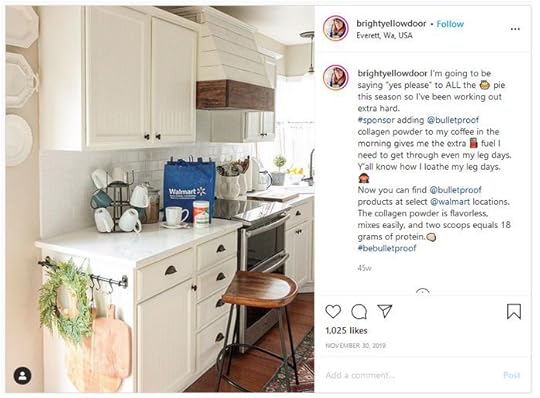
@brightyellowdoor / Instagram
So what do you love? Are you a proud parent, an animal lover, or someone with a unique and interesting hobby? Make sure that’s reflected in your Instagram content, because you never know the opportunities it might open up!
Creativity balanced with respect for brand
When it comes to social media influencing, it’s often highly creative people who do well. That’s because they can think of fun, memorable, and engaging ways to make their point. Therefore, brands often love partnering with creative influencers who can bring their own ideas to the table and create a truly unique partnership.
However, influencers also need to be willing to defer to brand identity in some ways. Brands don’t want to work with someone whose attitude is “my way is the only way.” Therefore, remain adaptable and come to the table with a brand as a collaborator. Share your ideas and get creative, but take their needs into consideration, too. If you’re too difficult to work with, they won’t come back a second time.
Here’s an example. Influencer Julia Zelg (@juliazelg) is known amongst fans for her eye-catching outfits and bright pink hair. In this partnership with fashion brand @aprilalexshop, she kept her unique sense of style while swapping out pink hair and makeup for bright blue to better complement the brand’s identity:
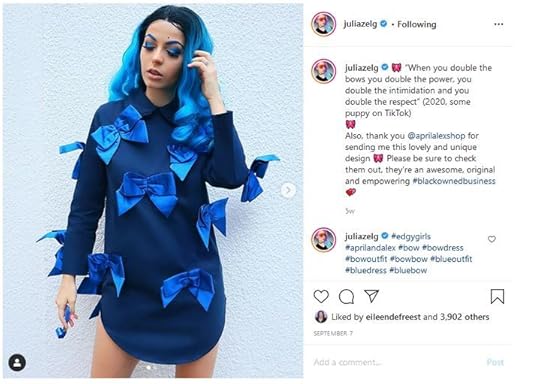
@juliazelg / Instagram
It’s entirely possible to remain true to your followers and audience while still adapting to suit a brand’s needs. You just need to be creative.
How to Build and Grow an Audience
Perhaps the most difficult aspect of becoming a successful Instagram influencer lies in building, growing, and retaining a loyal audience. You might have the most amazing pictures and the most creative and original content ideas, but if you don’t have people to share it with, you won’t be successful as an influencer.
How many followers do I need?
You might be pleased to know that the answer to this is probably not as many as you think. As already discussed, influencers come in all sizes and more followers isn’t always better. It can be just as rewarding to be a micro or nano influencer with a highly engaged and loyal following.
While more followers might get you a foot in the door with brands, it’s your engagement rates and the quality of your content that will close the deal. So focus on growing your audience, but put at least as much attention into growing your engagement rates and improving the quality of your content.
How do I increase Instagram followers?
There’s a short answer to this one: patience and consistency. You need to post high-quality content regularly if you want to build an audience, and it might take more time than you’d like to get there. There’s very rarely any such thing as overnight success in influencer marketing.
Here are a few other tips you can follow to help you get more new followers on Instagram:
Use video content, Instagram Live, and Stories, as well as posting the traditional Instagram photos.
Create an Instagram strategy and stick to a posting schedule. One per day at a minimum is ideal. Posting whenever you feel like it won’t cut it! Social media management tools help you post constantly at the right time
Undertake robust hashtag research and make full use of all the space for hashtags in every post. Effective use of hashtags will make sure that the right people see your content, even if they’re not following you yet.
Collaborate with other Instagram personalities and influencers. You can run takeovers, share each other’s content on Stories, or do “Spotlight on…” features where you share each other’s channels with your audience.
Keep an eye on your analytics. You’ll need an Instagram business account (which is free) for this. What type of content gets the most engagement? What times of day or days of the week yield the best response? Use that data to keep improving your Instagram content.
Host a contest or giveaway. Make sure you require people to follow you to be eligible for entry!
Whatever you do, don’t be tempted to buy followers. Your engagement rates will suffer and you won’t see the results you want if you have a lot of fake followers. It’s much better to take your time in building an audience of real people who genuinely love what you do and care what you have to say.
How to Monetize Instagram
You’ve chosen your niche, you’re creating quality content, and your audience is growing. Congratulations! Now what? Now it’s time to start focusing more on monetizing your Instagram account.
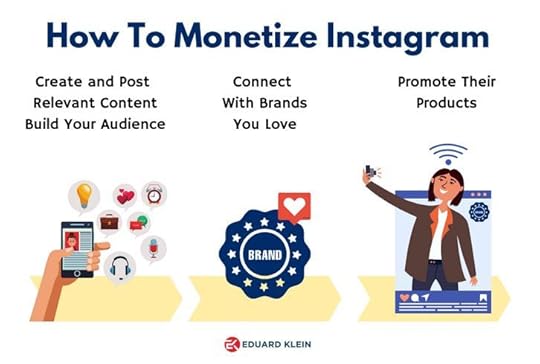
Source: Eduard Klein
Take a look at three great ways you can monetize your content as a social media influencer:
Try influencer marketing platforms.
An influencer marketing platform is a solution that allows brands to connect with prospective influencers quickly and easily. Some of these platforms select eligible influencers according to an algorithm. Others, however, allow influencers to list themselves in the hope that brands will find them.
Here are a few platforms you might want to check out to get started:
Afluencer: a one-stop shop for brands and influencers alike. You can get a free Afluencer account as an influencer and be the first to learn about great upcoming partnership opportunities.
Shoutcart: a platform where brands and influencers can buy and sell social media shout outs. In practice, it’s mostly centered on Instagram. Shoutcart is free to register for and easy to use, meaning it can be a great way to get your first paid partnerships.
Social Bond: an advanced influencer marketing platform. Influencers can join for free but can benefit from additional features such as access to more contacts, insight reports, and the ability to upload a media kit if they pay for the $9-per-month premium version.
These are just a few of the influencer marketplace platforms you might like to check out. Try a few different ones to see what works for you.
If you don’t have a huge following already, you can start with platforms like trend.io. They have a marketplace for brands that send you their products for review, and you get paid for the content you create.
Get direct connection with brands.
Another way to start monetizing your Instagram account is to connect with brands directly, rather than going through an influencer marketing platform. This can lead to opportunities for sponsored posts, which can be lucrative.
The best way to connect with a brand is to make sure your content shows up regularly in their Instagram feed. That means providing a consistent, steady stream of great posts and making sure you’re using the right hashtags. You should also use geotags to add your location to your posts, as many local and regional brands prefer to work with influencers in their area.
Another way to get the attention of brands you’d like to work with is to interact with their content. Comment on their posts regularly and reply to their Stories.
Finally, you can tag them on your content when it’s relevant. For example, if you find a new line of cosmetics you love, you could post a picture of your latest makeover and tag the company whose products you used. If you go to an amazing coffee shop or restaurant, take a photograph of your order and tag the brand in the caption, complimenting them on the food or service. Brands love to work with influencers who genuinely love their products, so be authentic, and when you find something you like, don’t be afraid to post about it.
Participate in affiliate marketing.
Affiliate marketing is another way many influencers make money on Instagram. Affiliate marketers work with brands under a revenue-sharing system. You share links to a company’s products and, when someone buys using your link, you make a commission. Some companies will also send you a free product, which you can use in your content, allowing you to give your readers a first-hand perspective.
Affiliate programs exist in every niche you can think of, and all reputable programs are free to join. You can join as many as you like, but start with just one or two.
Here are a few tips to help you get started with affiliate marketing on Instagram:
Choose products that are in line with what you want to be known for. If you’re a fashion and beauty influencer, choose a clothing or cosmetics affiliate program. If you’re a fitness influencer, choose home-gym equipment or fitness gear. And so on.
Find a niche within a niche. If you can cater to a highly specialized audience and do it well, you’ll be the go-to person for relevant products.
Wondering how you can promote affiliate products using Instagram, given the fact that you can’t add clickable links to your posts? Don’t stress — use the “link in bio” workaround and use an Instagram bio linking tool (like Linktree or lnk.bio) to collate all your links on one simple landing page that your fans can access from your Instagram profile. Once you have over 10,000 followers, you can also use the “swipe up” function to embed links directly into your Instagram Stories.
Essential Influencer Help Tools and Resources
If you’re keen to get started, you might be wondering what else you need to help you get started. While you can become an influencer with nothing but great content and hard work, it’s better to have a little help.
To help you, here’s a list of the best tools to grow your Instagram. It includes some of the best social media scheduling tools, Instagram analytics platforms, and content creation tools.
Here are a few other tools, resources, and tutorials you might want to look at, too:
A complete guide on how to become an Influencer.
Canva to edit your pictures and create beautiful, branded social media graphics. There are numerous other great graphic design software solutions you can try, too.
Socialrank to help you organize, analyze, and manage your audience on Instagram and Twitter.
Udemy for great and affordable courses on how to become an influencer.
Another Udemy course that will help you learn to monetize your Instagram as an influencer.
Bannersnack to help you create great Instagram stories. It’s very affordable, and there’s a limited free plan you can use to try it out before you buy.
Bannerbear to auto-generate social media visuals on scale.
Hashtagify to find the best hashtags to use with your content.
As you embark on your influencer career, you’ll undoubtedly find the tools that work best for you. The most important thing is to invest in the tools and resources you need and then use them properly.
Influencer FAQ
How much do influencers get paid?
It varies widely, so there’s no simple answer to this. However, please don’t be taken in by stories of instant wealth and lavish lifestyles just for posting on Instagram. It’s not quite that easy! Huffington Post interviewed various influencers about how much they make, and answers varied from $2,500 per year (influencer has 12,000 followers) to $150,000 to $200,000 per year (influencer has 134,000 followers).
Is influencer marketing ethical?
Yes.
At its best, influencer marketing is just getting paid to promote products you love and talk about things you’re passionate about.
As with anything, there are unethical ways to do it. For example, lying to your audience to make a quick sale or partnering with a brand known to have unethical practices is unlikely to go well. This will lead people to unfollow you and your reputation to suffer, but as long as you’re authentic and remain true to your values, it’s fine.
What kind of brands work with Instagram influencers?
All kinds!
While influencer marketing is particularly popular in industries such as cosmetics and fashion, brands across almost every niche you can think of work with influencers. This week alone there are influencers advertising products as varied as gym equipment, pet products, children’s toys, and software packages.
What kinds of people can become influencers?
Again: all kinds!
There’s an unfortunately prevalent stereotype that leads people to think only those who look like models can become influencers. But that’s simply not true. A great influencer doesn’t need to look a certain way or be a particular age or gender. They just need to be knowledgeable and passionate about their niche and know how to offer fantastic content.
Time to Get Started!
Hopefully this article has given you all the grounding you need to get started. Succeeding as an influencer takes time, patience, and effort. But if you invest all of those things and create great content on a consistent basis, your audience will grow more quickly than you think.
Here’s to your first brand collaborations!
By Eduard Klein
November 3, 2020
Is TikTok Getting Banned? Here’s What We Know So Far

NOV. 4, 2020
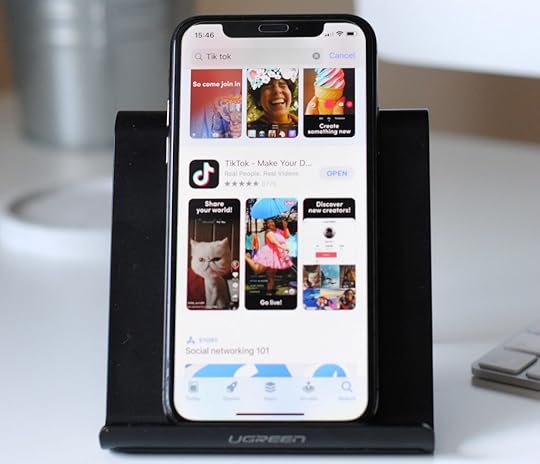
Hello I’m Nik / Unsplash
Fans of TikTok, whether a creator or a silent viewer, scrolling endlessly as the night hours tick by, have most likely heard the rumors that TikTok is getting shut down. But since you can still open your app and bring up your favorite videos, how true is this hearsay?
There was a bit of a hurry-up-and-wait situation with TikTok, with in-the-know fans expecting the entire app to essentially disappear in mid-September. That didn’t happen, but the outlook still isn’t positive for the app or its committed users. Here’s what’s going on.
How This All Started
President Trump considered banning TikTok.
In July of this year, President Trump considered banning TikTok. Some said this was to punish China for its relation to the COVID-19 pandemic while others (including the government) said that it was for the sake of protecting the privacy of U.S. citizens. (Note that a spokesperson for TikTok said that the service does not collect data from Americans.)
Donald Trump confirms the government is considering banning TikTok due to national security concerns:
“We’re looking at TikTok, we’re thinking about making a decision.”
— Pop Crave (@PopCrave) July 29, 2020
What Happened Next?
Trump suggested a purchase of TikTok.
Around the beginning of August, President Trump said that TikTok can’t be controlled security-wise by China because it’s too large and invasive. He wanted a large, secure, American company, like Microsoft, to buy it. He also suggested that a company like Microsoft purchase the entirety of TikTok instead of a percentage of it, stating that it would be too complicated to buy a percentage of the company, partly because of the issue over which owner would get the TikTok brand name.
The goal was to have TikTok purchased by September 15 (though September 20 was also a date mentioned by some outlets); otherwise, its operations in the U.S. would be shut down. Furthermore, Trump wanted the U.S. Treasury to get a lot of money out of the purchase deal.
How Did TikTok Respond?
Their federal court complaint (and more).
On their website, TikTok put up a blog post saying:
“The Executive Order issued by the Administration on August 6, 2020 has the potential to strip the rights of that community without any evidence to justify such an extreme action, and without any due process.”
The blog post also had excerpts from their official complaint filed with the federal court, including this one:
“By banning TikTok with no notice or opportunity to be heard (whether before or after the fact), the executive order violates the due process protections of the Fifth Amendment.”
Then, by the end of August, TikTok’s new CEO, Kevin Mayer, resigned.
And, as you’d expect, TikTok users started talking about the situation on their feeds as they prepared to leave the platform. They encouraged their fans and viewers to join them on other social sites, like Instagram, to continue watching their content. Overall, though, there was a shared feeling that TikTok is one-of-a-kind and difficult to replace.
Did Any Companies Consider Buying TikTok?
Big names competed for the purchase.
Major companies like Oracle, Walmart and — yes — Trump’s suggested Microsoft considered purchasing TikTok. Microsoft even posted to their blog on August 2 about the potential purchase, saying:
“Microsoft will move quickly to pursue discussions with TikTok’s parent company, ByteDance, in a matter of weeks, and in any event completing these discussions no later than September 15, 2020. During this process, Microsoft looks forward to continuing dialogue with the United States Government, including with the President.”
If you’re wondering, “Why Walmart?” since they’re not exactly known as a tech giant, the answer is simple: TikTok has the opportunity to sell products to consumers, making it attractive to a big retailer, especially one with budget-friendly prices that appeal to TikTok’s young user base.
Ultimately, though, it seemed that Oracle had won the bid. While details of the plan weren’t totally clear, it seemed that the company would have a majority stake, but ByteDance (TikTok’s parent company) would still have a pretty strong minority stake, and it wasn’t known whether or not that deal was supported by Trump.
Then What Happened?
TikTok was given a new end date.
Anyone who’s an avid TikTok watcher knows that they can still access the app, and it seems that creators are still making new content , so it hasn’t been effectively or fully shut down…yet. There still isn’t an official buyer (details about and support of the alleged Oracle purchase were fuzzy at best), and it seems that the purchasing deadline has been pushed to November 12, which is when a deal has to be finalized by. WeChat has also taken a hit due to similar security issues (or suspected security issues), with a federal action limiting how money can be transferred and how payments can be made in the United States.
But even though you can technically still use the TikTok app, whether you’re a creator or a viewer, you can’t actually take advantage of app updates anymore, and if you don’t already have the app on your phone, you can’t download it, either. When an app can’t receive necessary updates, it can start performing poorly and even leave your phone open to safety and security issues. Updates often include must-have patches that keep the app, your phone, and you safe.
What happens mid-November? Once November 12 comes, the deal is the same as it was with the September 15 deadline: If there isn’t a buyer and a finalized purchase deal, the app will be shut down. In the meantime, there are debates about how safe TikTok actually is right now versus its proposed safety should it be purchased by an American company. There are also discussions about whether or not this control by the U.S. government is actually reminiscent of the authoritarian government in China instead of being democratic. And, since the original deadline passed, there’s also the question of if the ban will actually take place at all.
By Lindsay Pietroluongo
November 1, 2020
How to Boost Your Sales with the Right Product Video

NOV. 2, 2020
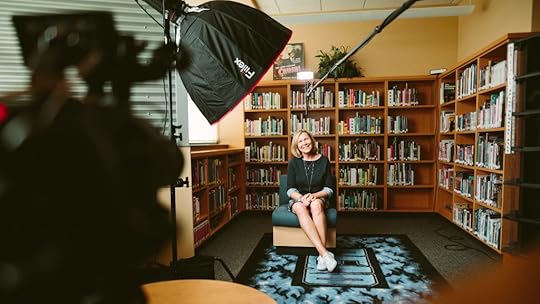
Sam McGhee / Unsplash
Yesterday, a clothing brand asked its followers in an Instagram Story poll whether they prefer photos or videos of their products. Can you guess which option had the most votes?
Videos.
It’s not hard to see why: They offer a more comprehensive view of an item or service than photos ever could. As a result, customers feel more confident about buying the item, especially when the whole transaction, from product discovery to purchase, takes place exclusively online.
Having said all that, not any video does the trick. If we’re talking e-commerce, the quality and meaningful design of your piece will determine if it helps your efforts or detracts from them.
So today, we’ll focus on how to create an awesome product video that can actually bring a positive impact to your bottom line, looking for that style that’ll fit best with your video marketing strategy.
Don’t Just Display Your Product – Showcase Its Benefits
A great product video isn’t supposed to just show nice shots of your product or mention its coolest features in passing. You need to tell your audience why your item or service is what they’re looking for.
Consumers don’t purchase an item because of the product itself but because of what’s in it for them. Here lies the difference between telling your audience that your watch shows the time of day and expressing that it would prevent them from being late to important meetings. The item is the same in both cases, but its appeal changes greatly, don’t you think?
Here’s an example from Apple, which outlines all the benefits the watch offers to consumers.
This is the first thing you need to define about your product or service before setting off to promote it: the benefits it can bring to people.
Build Your Video Around Your Target Audience
Relatability is one of the most important, if not the most important, aspects of any story. Without relatability, your piece won’t impact your audience, and it will be quickly forgotten. Those words may sound ominous, but it’s no exaggeration. People only give their full attention to the stories they can identify with; otherwise, they just look the other way.
For this reason, it’s vital to write your video script with your target audience’s characteristics in mind. Think about their general interests, age group, economic and education level, everything that makes them your target audience. Set off to create a story that can resonate with them. That entails making every element of the script relatable to your specific audience. It may sound a bit overwhelming, especially for the inexperienced, so we’ll go through each element.
1. The characters
A relatable script has relatable characters, as simple as that. It stands to reason that your video’s protagonist has to embody your target audience to resonate with them.
It sounds like a no-brainer, and still, you won’t believe how many videos miss the point here, especially live-action ones. Examples abound: Just think about those commercials meant for working mothers that feature a twentyish model-looking actor. Not very on point, right?
To hit the nail in the head, try modeling your main character around your buyer persona – that is, the representation of your ideal client. Here’s an example:
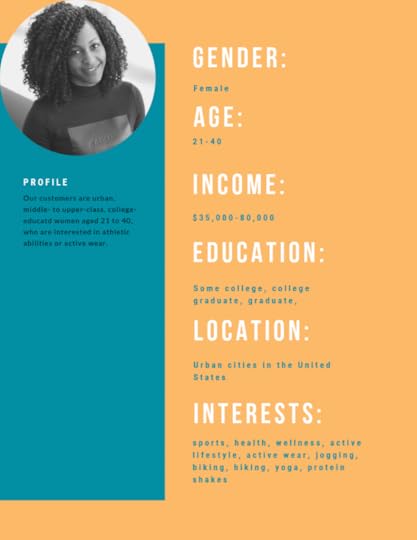
2. The story
To really strike a chord with your target audience, you must show situations they may see themselves in. Even better if you tackle their pain points (a formula that’s often used in most effective explainer video scripts). The idea here is to hit them where it hurts, but with good intentions. To clarify: Your relatable character should endure a problem that’s common to your target audience. More precisely, the problem your product or service is meant to solve!
All this is closely related to showcasing your product or service’s benefits. If you think once more about the watch example, you’ll see that the item is portrayed as a solution to arriving late to meetings. That’s what calls the viewers’ attention.
3. The context
Showing your characters in a relatable situation also means displaying them in a place and context that’s familiar to your target audience. Here comes into play all the information you’ve gathered about them and their lifestyles. Are they the type who go to work by bike? Are they likely to spend hours stuck in traffic? Would they rather hang with their friends, family, or significant other?
Of course, these questions are just mere examples of the many that you should ask yourself before deciding where and how to situate your character. Although there’s not an objectively right answer to these sorts of questions, it’s safe to say that the right option will always be whichever one matches your target audience the most.
Choose the Right Product Video Style
Product videos are a world of their own. There are various types to choose from, and each has different pros and cons. So, how to know which one to pick? Once again, it depends on your target audience. After all, you should go with the style that can suit their informative needs best.
Your decision also depends significantly on your product. As you are about to learn, some styles work better for B2B or complex products, while others are popular in the IT industry, and so on. To simplify your decision-making process, here’s a list of the main product video styles. Have a look!
1. Explainer videos
Explainer videos are the go-to option for any company that needs to promote a complex product or service.
Some products or services can’t be fully appreciated with a simple commercial, especially if their main features are related to technological or scientific advances. These kinds of products or services can particularly benefit from explainer videos, which are meant to boil down any topic, however complex, into a simple explanation of around 90 seconds. Here’s an example:
2. How-to videos
Also known as tutorials, how-to videos are educational pieces meant to teach your audience how to use your product or service. They are of great help to both potential and current customers alike. The former can benefit from knowing whether the product is user-friendly and the latter from learning how to handle it correctly.
Depending on your product, you may consider making a series of how-to videos featuring your item’s different possible uses. Imagine, for instance, you are selling a food processor. In that case, you could provide various tutorials on how to chop vegetables, blend ingredients, crush ice — you get the idea.
Here’s an example of a how-to video from Starbucks.
3. Demo videos
Just like tutorials, demo videos show how to use a product. However, they have a very particular way of doing so – by demonstration (hence the name “demo” video).
These videos don’t give an explicit explanation of a process. Instead, they show somebody going through it. That said, it’s usual that the individual describes what they are doing (sometimes in great detail) and gives recommendations to viewers.
You have probably seen one of these types of videos before, most likely under the form of a screencast video. That is the most popular type of demo video, and they are particularly useful during the latter stages of the sales cycle.
Here’s an example of a demo video:
4. Review videos
These videos often consist of a content creator giving their opinion on a particular product and weighing its pros and cons. These videos are usually user-generated, but that doesn’t mean they can’t be sponsored. In fact, brands can highly benefit from sponsoring review videos.
First off, these are perceived as reliable. People tend to trust review videos, although mostly when they aren’t sponsored. They believe they are watching a (supposedly) unbiased opinion on a product, so they often watch these videos before making a big purchase.
Equally important, review videos are often produced by influential content creators who have an engaged community around their videos. So, if you associate with an influencer related to your field, you’d be addressing your target audience in a cost-efficient way.
Here’s an example of a review video:
5. Unboxing videos
Also user-generated and potentially sponsored, unboxing videos showcase a content creator taking a product out of its box for the first time. They are similar to review videos in the sense that the influencer often gives their opinion of the product, but they differ in many other aspects.
To begin with, unboxing videos are way more centered on the looks of the product rather than on its performance. After all, the user has just received it, so they couldn’t use the product enough to do a thoughtful review about it.
Second, unboxing videos are all about the content creator’s reactions while seeing the product for the first time. That’s why these videos are, more often than not, more entertaining than useful. Still, many people watch unboxings to know what to expect from an item they wish to purchase. Here’s an example:
To Wrap Up
If this article was called “How to Boost Your Sales with any Product Video,” it may attract more readers. However, the truth is that not every product video can deliver excellent results. Only those that have a relatable script, written with your target audience in mind, can succeed at striking a chord with viewers.
That said, your target audience not only comes into play when writing the script but also when you are deciding which type of product video to go with. Today you have seen there are many options out there, some more suitable to your audience and your product than others.
Now you have the recipe for creating the right product video that can boost your sales, all that’s left to do is produce it! Good luck!
By Victor Blasco
October 30, 2020
How to Create an Amazon Post
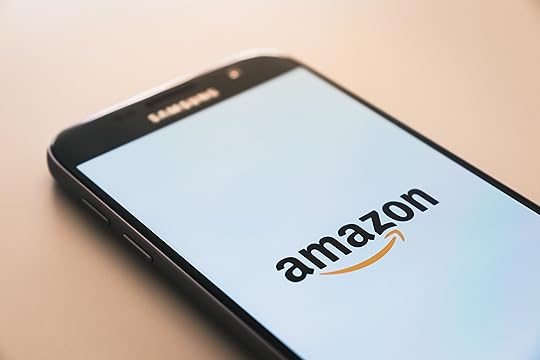
http://www.advertisemint.com/wp-content/uploads/2020/10/posts_a20m_demo_update._CB425377566_.mp4
Source: Amazon
Amazon is currently beta testing a post feature for the mobile shopping app on iOS and Android. Appearing on a brand’s product listing, this new feature is just like any other social media post you see online, with a large image followed by a headline and CTA button underneath. When clicked, it redirects customers to an Amazon post, where the brand’s products are listed.
Sellers registered in the Amazon Brand Registry, vendors, and agencies representing vendors are eligible to use Amazon Post. Although you don’t have to advertise with Amazon to create posts, you must sell products on the platform to qualify.
Here’s how to create an Amazon post.
Step 1: Go to this page then click “Get Started.”
If you’re not already logged in to your Amazon account, you will be prompted to do so.
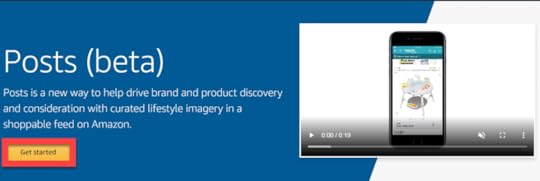
Step 2: From your Amazon account, click “Campaigns.”
Once logged in, go to your account console and click on the first option, “campaigns.”
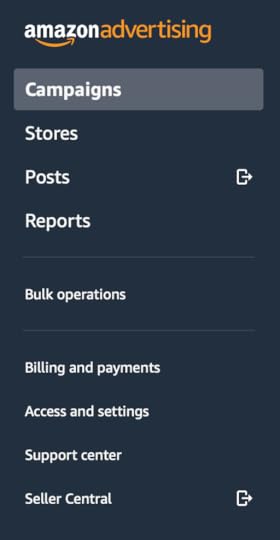
Step 3: Select the brand that you want to create a post for.
If you own multiple brands, click the one you want to create a post for.
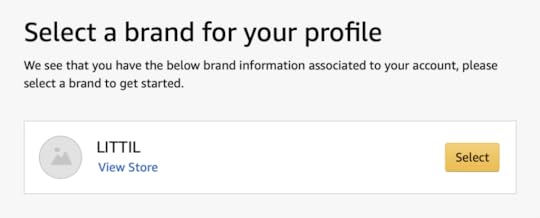
Step 4: Click “Create post.”
You will be prompted to create a post. Click “Create post.”
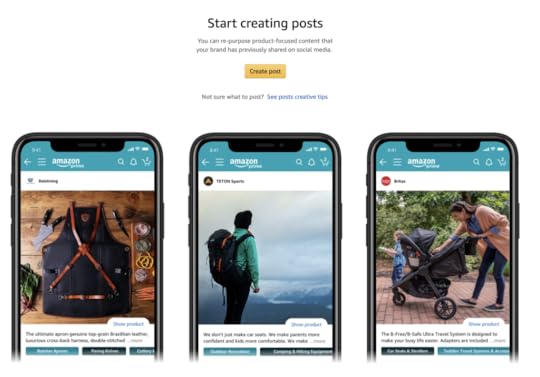
Step 5: Skip through Amazon’s post recommendations.
Here, Amazon will give you examples of best practices for creating posts. You can go ahead and skip these if you prefer. To do so, click the “close” button on the bottom-right corner. If you believe these recommendations will be helpful, go ahead and examine them by clicking the forward arrow button on the right side.

Step 6: Create your post.
To create your post, you need to provide the following:
An image in either the JPG or PNG format
An image that is 640 x 320 pixels or larger
A caption
The list of products you want to feature in the post
You can either save the post as a draft (if you want to revisit later) or submit to Amazon for review.

Step 7: Analyze post performance.
You can track the performance of your post here. You will be able to view post impressions and engagement.
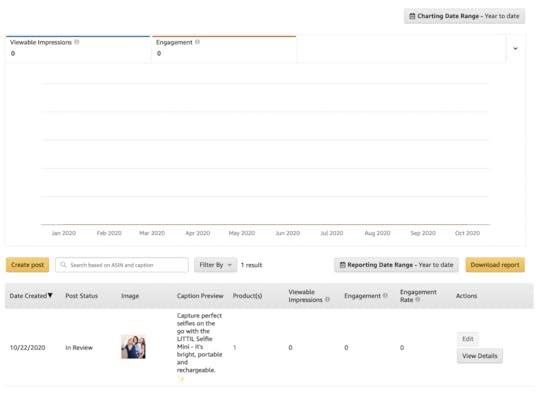
There you have it — the steps to creating an Amazon post.
Amazon Post Recommendations
What makes an attention-grabbing, high-converting Amazon post? Great question. This is what Amazon recommends to keep in mind when creating your posts.
Tip 1: Feature product and value.
Rather than featuring a product with a lot of white space (left image), showcase the product in a lifestyle photo (right image). It’s also helpful to place your product in a realistic setting or in a situation that shows how it’s used.
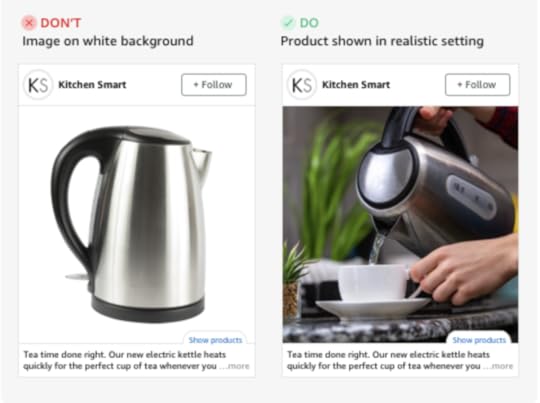
Tip 2: Use simple images.
Users scroll through feeds very quickly, so you want to make sure they can easily understand the message your image conveys at first glance. Feature simple images. Make it too complicated, and it might take potential customers too long to try to decipher, and at which time, they might already have lost interest and moved on.
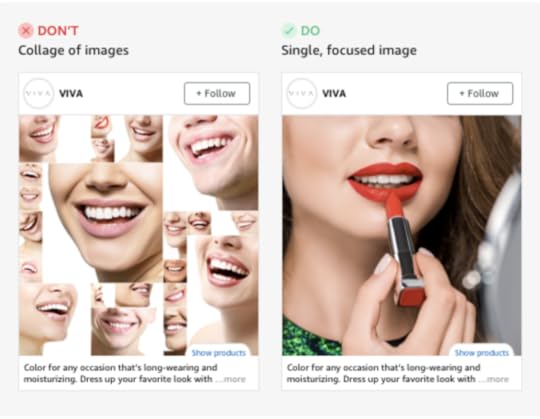
Tip 3: Don’t feature too much text.
You’ve heard this one before, especially if you’re a Facebook advertiser: Don’t include too much text. There’s a reason. Adding too much text on the image distracts from the product. It also takes too much time to read and may even be too small to decipher. You want to catch attention as quickly as you can. If your message takes too long to understand, your customers will move on. Instead, make sure to choose an image that speaks for itself. After all, a picture is worth a thousand words.
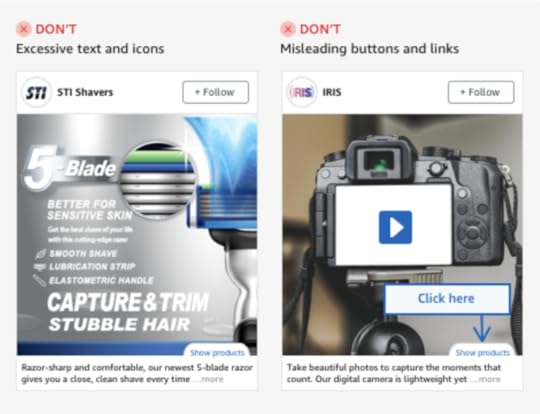
Tip 4: Upload high-quality images.
What makes a high-quality image? For one, it’s not pixelated, stretched, or blurry. It’s also cropped correctly so it fits perfectly on the screen; meaning, no images with extra space (left image). Appearance matters because it’s a reflection of your brand credibility. It’s easy to conclude that if your brand is careless enough to publish posts with low-quality images, then that brand is also likely to be careless enough to produce low-quality products.
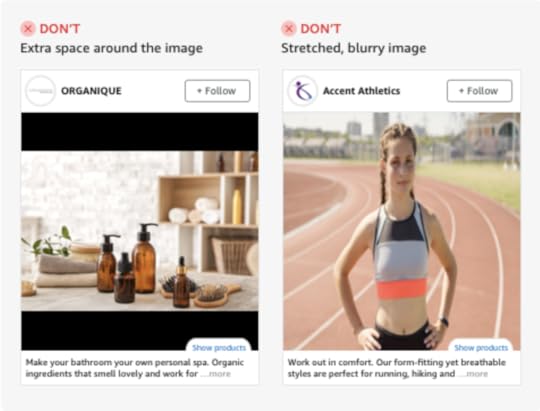
Tip 5: Tell a story.
Each post contains a caption, where you get the chance to talk about your brand or products. Use this space to tell a story. Talk about the aspects that makes your product unique. Talk about why customers should choose your brand. Tell them the benefits you can offer.
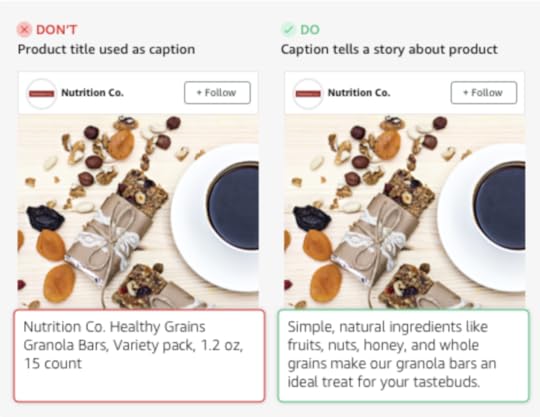
Amazon is testing a post feature that will bring brand and product awareness. Jump on this opportunity, and when you create your posts, make sure to keep Amazon’s recommendations in mind to get the best results.
By Anne Felicitas



